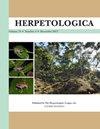欧洲绿蜥的天然食性——绿蜥科(Lacerta viridis):宏观和分子鉴定方法的比较
IF 1.1
3区 生物学
Q2 ZOOLOGY
引用次数: 0
摘要
分析爬行动物的饮食对于理解爬行动物在生态系统中的作用和成功的保护管理计划的采用是必不可少的。为此目的,非侵入性和侵入性方法被用来识别被吃掉的猎物。在这里,我们研究了雄性和雌性欧洲绿蜥蜴(Lacerta viridis)的饮食,通过在春季和夏末在一个地点取样粪便颗粒,历时两年。我们使用了以下两种方法从粪便样本中识别猎物残留物:一种是需要专业知识的经典宏观方法,另一种是基于未降解猎物残余DNA的膳食元条形码的分子方法。根据这两种方法,蜥蜴主要捕食13目昆虫,以鞘翅目昆虫为优势猎物。雌雄间捕获类群数量相似,但属水平上的猎物组成差异显著,雄性捕获的鞘翅目动物多于雌性。不同季节的饮食也有显著差异。在春天,蜥蜴消耗的猎物种类和鞘翅目标本比夏末多得多。不同鉴定方法所鉴定的猎物类群比例差异显著。在已鉴定的猎物中,宏观鉴定只得到50%左右的分类群,而分子鉴定得到80%以上的分类群。我们的研究结果表明,分子鉴定比宏观方法可以恢复更多的猎物数量,但不是所有的猎物。因此,两种方法的结合最好地描述了欧洲绿蜥蜴的自然饮食和复杂的营养相互作用。本文章由计算机程序翻译,如有差异,请以英文原文为准。
Natural Diet of European Green Lizards, Lacerta viridis (Squamata: Lacertidae): A Comparison of Macroscopic and Molecular Identification Methods
An analysis of the diets of reptiles is essential for understanding the role of reptiles in the ecosystem and the employment of successful conservation management plans. For this purpose, noninvasive and invasive methods to identify consumed prey have been used. Here, we investigated the diet of male and female European Green Lizards (Lacerta viridis) by sampling fecal pellets across 2 yr in the spring and late summer at a single site. We used the following two methods for identifying prey remnants from fecal samples: the classical macroscopic approach that requires competent expert knowledge and the molecular approach based on the dietary metabarcoding of nondegraded prey remnant DNA. According to both methods, lizards consumed mainly insects belonging to 13 orders, with Coleoptera as the dominant prey. The number of prey taxa was similar between the sexes, but the prey composition at the genus level was significantly different, with males capturing some coleopterans more than females. The diets also differed significantly between season. In the spring, lizards consumed many more prey types and many more coleopteran specimens than in late summer. The proportion of identified prey taxa was significantly different between the identification methods. From the total of identified prey, macroscopic identification yielded only about 50% of taxa, whereas molecular identification yielded more than 80% of taxa. Our results show that molecular identification can recover a much higher number of prey than the macroscopic method, yet not all prey. Thus, the integration of both methods best described the natural diet and complex trophic interactions of European Green Lizards.
求助全文
通过发布文献求助,成功后即可免费获取论文全文。
去求助
来源期刊

Herpetologica
生物-动物学
CiteScore
4.60
自引率
0.00%
发文量
27
审稿时长
>12 weeks
期刊介绍:
Established in 1936, Herpetologica is a quarterly peer-reviewed journal serving herpetologists, biologists, ecologists, conservationists, researchers and the scientific community. The journal contains original research papers and essays about the biology of reptiles and amphibians, and covers many relevant topics including: behavior, conservation, ecology, genetics, morphology, physiology and taxonomy.
 求助内容:
求助内容: 应助结果提醒方式:
应助结果提醒方式:


